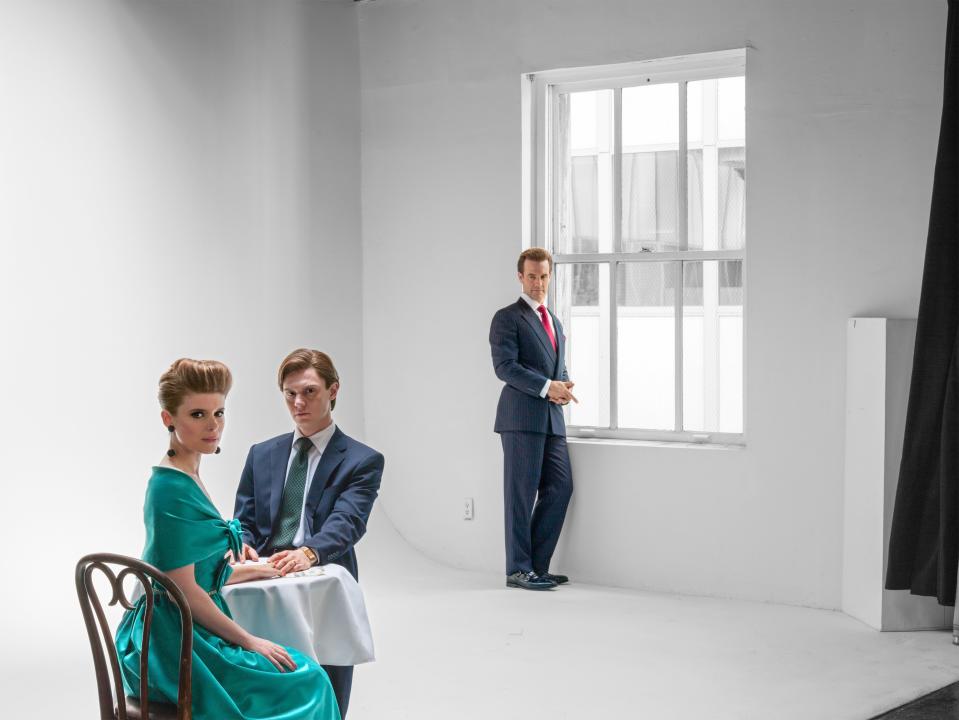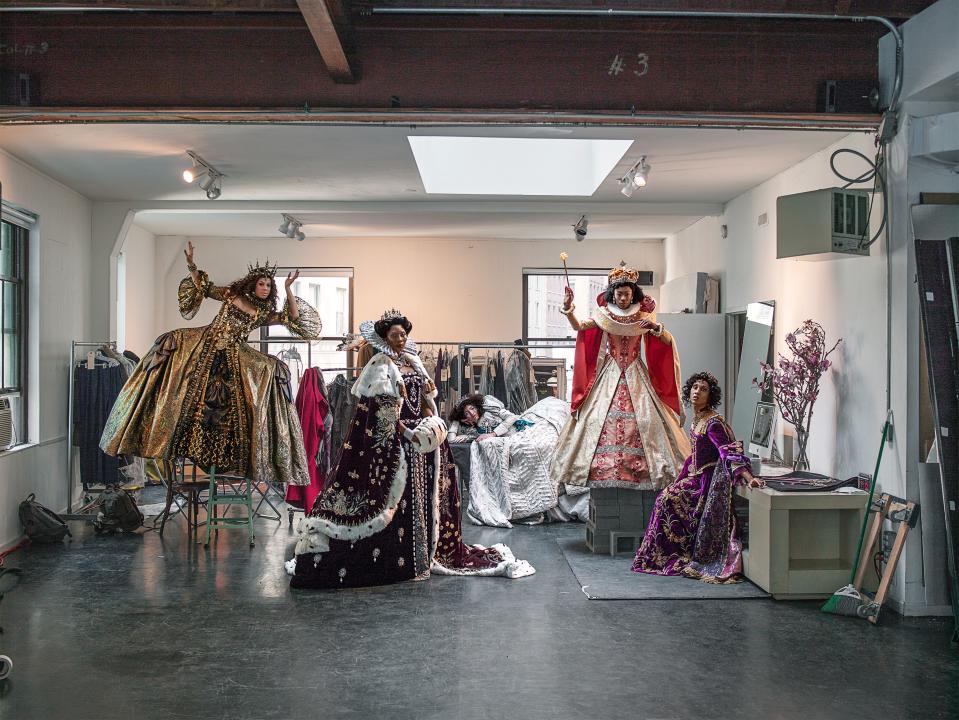Inside Pose , Ryan Murphy’s Evocative New Television Series
Pose, Ryan Murphy’s evocative new eight-episode series (premiering June 3 on FX), weaves a narrative between the worlds of eighties Gordon Gekko–esque high finance and Trumpian conspicuous consumption on one hand and the tragedy, invention, and joy of the competitive Harlem ball scene on the other. A decade ago, following on the success of his series Nip/Tuck, Murphy had been working on Pretty/Handsome, a pilot about a trans character, played by Joseph Fiennes, and was devastated when the studio he was working with decided not to pursue the show because they felt their advertisers wouldn’t support it. A mere month later, though, Murphy’s Glee was green-lit, and then American Horror Story, The Normal Heart, American Crime Story, and Feud, and now, with a decade of phenomenal success under his belt, he finds both himself and the world in a very different place. “I’m at this point in my career where I think I can get pretty much anything I want on the air,” says Murphy, “and I put my money on this.”
After initially deciding to option Paris Is Burning—the electrifying 1991 Jennie Livingston documentary that serves as most people’s entry point to the underground LGBTQ ball culture, where members of various “houses” compete against one another—Murphy was met with resistance from surviving family members of several of its key figures. Meeting the Afro-Latino writer Steven Canals, though, gave him a renewed focus. Canals was working on a script about Damon, a young African-American boy (played here by the endearing newcomer Ryan Jamaal Swain) with dreams of becoming a dancer. After Damon is thrown out of his home by his righteous Christian parents when they discover that he is gay, he is forced to survive on his wits in New York City before joining a kind of surrogate family—an experience that mirrors that of several of Pose’s cast and crew.
Murphy and casting director Alexa L. Fogel spent six months in the community before emerging with a roster that showcases more trans people—both in front of and behind the cameras—than any other project in television history. (The cast includes trans actresses Mj Rodriguez, Indya Moore, Hailie Sahar, Angelica Ross, and the commanding Dominique Jackson, a legendary figure in the ball scene.)
The Tony- and Grammy-winning Billy Porter, who plays Pray Tell, the hilariously shade-throwing master of ceremonies at the balls, claims that he didn’t have to do any research for the project. “I lived it,” he says. “My life has been the research—choosing truth and taking all the hits that have come with that: thirteen years of no work, of bankruptcy, living on sofas, living in the car. I’m so grateful that I lived long enough to see this time.”
Ross was a showgirl in drag performances at bars across the country, often working mainly for tips. Rodriguez grew up in a supportive home environment in Newark—her mother had a friend with whom she would attend the balls and “duel” dance together. She watched Paris Is Burning when she was twelve and was mesmerized by Octavia St. Laurent, “the icon—alongside Sylvia Rivera and Marsha P. Johnson—that any trans woman would look up to.” At fourteen, telling her mother that she was attending an after-school program, Rodriguez experienced the ball scene for herself, finding both community and comfort there. “That’s why we are here today, able to do a show like this—because people in the LGBT community fought for us.”
Jackson is a case in point: She survived a traumatic childhood on the Caribbean island of Tobago. “Once you start crossing over and displaying feminine ways, you’re a target,” Jackson says. “It’s sad, it’s humiliating, and it’s confusing.” After a number of suicide attempts, Jackson fled to Baltimore and found herself in the ball culture there, living with a supportive network of friends. “We slept on the floor and ate potatoes, and everyone in the house were my brothers and sisters,” she recalls. “I could live in my truth.” Soon she moved to New York and walked at her first ball. “The entire room just erupted,” says Jackson, who stands six feet two in flats and carries herself with a proud swagger that is equal parts Naomi Campbell and Diahann Carroll in Dynasty. “By the time I got to the front of the judges’ panel, they were handing me a trophy.”
Of course today’s political reality, as producer, writer, and director Janet Mock notes, creates its own issues. “The heightened visibility that we have is amazing—but it also makes our communities targets,” she says. “It’s no coincidence that violence against trans women of color has risen over the course of the last two years as we’re being pushed out of public spaces and restrooms and schools and the military and denied health care. Right now I think we’re craving portraits of ourselves where we’re the center of the story, not the martyrs.”
Since Murphy estimates that 95 percent of his cast have never acted in front of a camera before, Pose was a learning experience on both sides. (For the first time in his career, he notes wryly, he followed advice from his collaborators.) Two of the four writers on the series are trans, and no one’s shy about coming forward if they feel a word or a look rings inauthentic.

Murphy and his Pose team reached out to historic figures in the ball community (and hired paid consultants as well)—the judges in the series, for example, are among the survivors from those seen in Paris Is Burning. Murphy is also giving all of the profits from the show back to the trans community via college scholarships, youth-shelter protection, and health-care programs with a focus on HIV prevention.
That word—survivors—isn’t used lightly. “People were surviving a plague,” says Mock of the devastation wrought by HIV/AIDS. “At the same time, people can’t just live off trauma. I tried to center my writing in a way that shows the brilliance and the creativity and the resilience in the midst of all these forces.”
Murphy grew up in Indianapolis, with a conflicted relationship with his family over his teenage sexuality, and so after high school worked three jobs to put himself through college in nearby Bloomington. “I never really had a place,” he says, “and I think one of the reasons that I’ve been so ambitious has been to create a place.” He now employs 1,000 people. “We support each other,” he says. “It’s become a family affair, which is always what I wanted.”
He says that Pose is his most expensive production to date, and it certainly looks the part. His longtime costume collaborator, Lou Eyrich, draws from a trailer full of wonders gathered with her associate Analucia McGorty, who road-tripped across the country piling up her car with vintage finds at stores from Santa Fe to Minneapolis (and grappled with the challenges of finding period shoes in size 10 to 14). While the moneyed Elektra (Jackson’s character) references Iman and Vogue (and flaunts a wardrobe including originals by Mugler, Lacroix, and Versace), Ross’s Candy looks at Patrick Kelly and cotton-candy colors, Moore’s Angel is dressed in what Eyrich calls “Bohemian hippie meets Taxi Driver,” and Sahar’s Lulu has a “curvy, Janet Jackson vibe” and an inspiration board filled with images of a young Whitney Houston and pages from Ebony and Jet.
The young newlyweds Patty and Stan (Kate Mara and Evan Peters), meanwhile, live the white New Jersey suburban dream—with Peters inhabiting an aspiring Gordon Gekko–like character—while James Van Der Beek plays the chemically stimulated Trump-world titan Matt. (Van Der Beek describes Matt’s wardrobe as “bulletproof”: “I mean, my character’s initials are monogrammed on the inside of my sleeve.”)
Production designer Jamie McCall (and Judy Becker, who designed the first two episodes) struggled to capture the grittiness of New York in the eighties and had to research far into the outer boroughs to find locations that looked authentically ungentrified. Meanwhile, Murphy and his creative team looked at period references as eclectic as William Friedkin’s Cruising, Martin Scorsese’s The King of Comedy, Alan Parker’s Fame, and Adrian Lyne’s Flashdance, along with Oliver Stone’s Wall Street. For Murphy, Frank Simon’s cult 1968 documentary The Queen (about “drag queen” beauty-pageant contestants, as they were once described) has added resonance, as does Mahogany, the splendidly campy 1975 Diana Ross vehicle. “It’s all about the haves and the have-nots,” he explains, “the Trump world versus the ballroom-artist world. Baroque, stunning stuff juxtaposed with poverty—and that idea of how you create magic on a budget.”
Freed of such restraints himself, Murphy and his team have created their own brand of magic. At the cast-and-crew screening of the first two episodes, Mara says, “people were screaming at the screen and clapping and cheering for each other—we all exhausted ourselves from laughing and crying.”
“It was transcendent,” Van Der Beek says, “because I was watching a group of people watch their story being told in all of its complexity, with sincerity and with class, maybe for the first time.”
Murphy’s ambitions for the show, while far from modest, have little to do with ratings or critical acclaim. “Television is perhaps our most intimate experience,” he says. “When you watch television, the characters you watch become your friends—you let them into your house; you invite them into your world. You see their pain, and you understand them; it changes your perception. I know that from Glee. We were on the shoulders of Will & Grace and Modern Family, and I think those three shows helped bring about gay marriage in this country. And I think people who see these characters will love these characters.”
“I just hope this changes minds and hearts,” says Rodriguez. “That’s all.”
In this story:
Sittings Editor: Phyllis Posnick.
Hair: Chris Clark, Barry Lee Moe, Jameson Eaton, Sabana Majeed; Makeup: Sherri Berman Laurence; Nicky Pattison Illum, Chris Milone, Deja Smith.
Produced by Leone Ioannou at Pony Projects; Set Design: Peter Klein.
Wardrobe: Lou Eyrich, Analucia McGorty, Christina Hirbar, Rudy Mance, Jim Hammer, Darryl Glover.
Prop stylist: Patrick Head.


